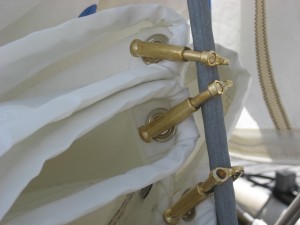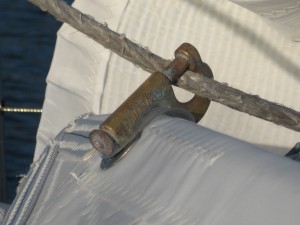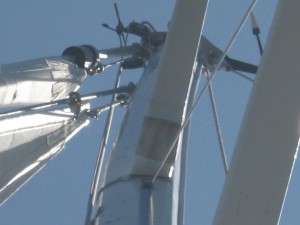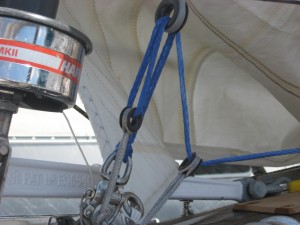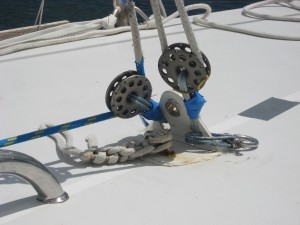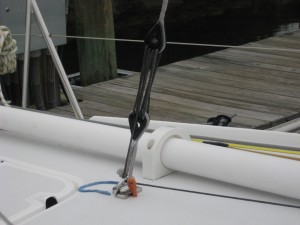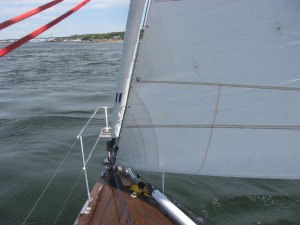In an earlier post I proposed a second stay, called a Solent Stay as a way to be able to deploy the correct sail for the conditions, without struggling with lowering the regular roller furling headsail. In this post I elaborate on the details of the stay and its component parts. It is worthwhile noting that some of the French boats, Beneteau and Jeanneau in particular offer much of the required hardware for a Solent set up on the spar and deck with the basic spar package.
The components of a Solent stay are:
- The stay
- Attachment of stay to the mast
- Attachment of the stay to the deck
- A mechanism for tensioning the stay
- A halyard sheave
- Halyard exit in the mast, leading to a winch
- A halyard
- Possibly a turning block and related pad eye
- Possibly another rope clutch. This depends on how your boat has the rest of the lines laid out.
- Sheeting positions for the sails.
I will look at each item in detail below.
The Stay
Until recently standing rigging on boats was either wire or rod. The development of synthetic standing rigging (coming largely from the Open solo classes) has become normalized to the point where I have consulted on half a dozen installations of synthetic stays for boats.
The preferred material for a Solent stay is Spectra fiber, ideally the latest version, (and there are several and it is always being upgraded). The latest is a product called Dynex Dux which is a heat set Dyneema, (European name for Spectra) for this Solent stay application Dynex Dux is excellent because of its mechanical properties, being:
• High strength
• Light weight
• High resistance to UV
• High resistance to Chafe
• Ability to coil up and so stow in a small space
• Ease of splicing
• Relatively low cost &high value for a complete stay
It is a bit stiff and one rigger I know refers to it as Fiber Wire, but that is about the only down side I have seen.
Also the high resistance to chafe means, to me, that one can use conventional bronze hanks rather than the more expensive soft hanks. I do not think there is a need for “soft hanks” in this arrangement for most sailors. The value: Cost versus utility, is low in my opinion.
Attachment of stay to the mast and halyard options.
Generally speaking the upper end of the Solent stay will attach to the spar within 12 inches of the bottom of the Genoa halyard sheave box. Much of this detail depends on the particulars of the mast in question. Issues to contemplate are:
Age of the mast: This is not so much for mechanical issues but more due to obsolete hardware and design details on the spar.
The simplest and easiest way to attach a stay to a spar is with a Gibb T fitting.
Depending on the spar details you may need to install a sheave box under the stay attachment
OR
I have done a couple of boats where the halyard runs above the stay connection to the spar, via a dead dye and into the sheave box for the Genoa, using the spare Genoa halyard sheave. This works when there are two sheaves in the box. Charleston Spars has some boxes where the second sheave is below the Genoa sheave and this works too.
If your spar does not have this kind of arrangement, you will have to cut into the spar and install a sheave box.
Because the stay attaches to the top of the spar, running backstays are not required. This detail highlights a particular advantage of this stay layout over a traditional “cutter” stay.
The above image, taken from the deck, shows the head of the solent Jib and stay. Just under where the stay attaches to the spar,can be seen a Harken halyard deflector, leading the halyard around the stay and into a second Genoa sheave box.
Attachment of the stay to the deck and tensioning of the stay.
Historically second stays inside the fore-triangle have been tensioned with either a Highfield lever or more recently some kind of screw adjustment device. While this is an OK solution, this hardware is heavy and expensive, compared to a tackle as a way to tension the Solent (or any other inside stay for that matter).
A superior technique for tensioning a Solent stay is to install a multi part, I usually use 4:1, tackle with the tail leading aft where it can be readily led to a winch. This method has several advantages over a mechanical adjuster.
The above image shows the detail on the Baltic 38 used for tensioning the Solent.
This image shows part of the same idea on a J-105 that I sail on in many double-handed races.
The above picture is a version of tensioning. This taken from a 40 foot competitor in the O.S.T.A.R 2011
This image is of a Solent stay tensioning arrangement on a single handed Class 40.
The sail can be hanked onto the stay while the stay is restrained aft against the mast, thus the Solent sail can be close to all rigged and ready to go, before it is needed. The tackle helps pull the sail forward, so if there are two people on watch, the aft crew member can tail the fall of the tackle and the crew on the bow can help it stay clear of obstacles like mooring cleats, hatches, vents etc on the deck. The biggest advantage to my mind though is that the stay can be re-tensioned after a few hours of sailing. Typically when sailing in hard air, the inside stays (well all stays do actually) tends to stretch out a bit and so the sail lays off to leeward, affecting the boats performance. With the tackle led to a winch, the stay can be re-tensioned any time. Further, say the Solent is lowered yet still deployed forward, in anticipation of re- use shortly, but one finds a great need to tack in a hurry, (remember the stay sets right up against the back of the furler so there is no room to tack the Genoa thru that space, unless you roll up the Genoa), it is a simple and fast drill to open the clutch and pull the solent aft Versus trying to cast off a Screw thread turn buckle type adjuster or carry a sail and Highfield lever back aft, out of the way.
I prefer to have the load if the deck part of the tension mechanism spread across the deck as seen here:
This installation uses a double pad eye on center line, the aft part of which is used for the tack on the sail and a single, to port. The dead end is on the forward part of the double pad eye. The dead end has a snap shackle so as to minimize the amount of line one needs to pull around.
Depending on the construction detail of your boat, it may or may not be necessary to reinforce the deck in the way of the pad eyes. Again each boat will be unique in this detail.
Halyard, sheets and related & operating rigging issues
One of course needs a halyard on which to hoist this sail. This typically means either:
If you have had to cut a sheave box, then you will almost certainly have to cut an exit slit in the mast also. Make sure you look around the spar before you start making holes. You do not what to place the holes to close to each other.
OR
If you have a second Genoa halyard sheave there is a good chance you will have a matching slot for the halyard, it may even be moused.
Depending on how the boat’s winches are laid out, you will need to install a turning block at the base of the mast and possibly another clutch.
Other thoughts on this arrangement
Depending on what you are planning for the boat, it is perfectly acceptable for me to have the halyard winch for this sail on the mast. The idea that all lines need to be in the cockpit does not make sense to me in reality. For instance it is preferable I think to have the halyard for the Spinnaker to be at the mast. That way as you pull the sock down over the sail, you are able to keep control of it as you lower the halyard. It is worth noting that many of the latest crop of single handed offshore race boats has reverted to having some of the halyards, like the kite and the halyard for the roller reaching sails operable at the mast. Also having halyards at the mast minimizes the need for more hardware in the deck to lead the halyards aft.
You should also be aware of how a sails sheeting position is determined and make sure you have the requisite hardware n place and that the sails are built in accordance with where the hardware is. It is possible for a competent sailmaker to make perfectly viable remarks about sheeting positions with a view to better performance of the sail in questions, so be open to adding proper hardware to allow the sail to set properly.
I will be writing on the entire topic of sail sheeting geometry shortly
Next: what types of sails you can deploy on your new stay.
And here is a link to the story on Solent Stays I wrote for SAIL magazine in the Jan 2013 edition

